Answers to common questions about coyotes
IMPORTANT: Most coyotes are naturally shy and afraid of humans but if you encounter one, you should attempt to walk away slowly and make loud noises. If a coyote is in your yard, let the coyote know that it is not welcome by making loud noises (having a metal can with coins in it works well). Never attempt to touch, tame or feed a wild animal. It always ends badly for the animal because she will approach other humans who will not understand that she has been taught to associate humans with food. For more information on how to avoid conflicts with coyotes, see the Conflicts & Coexistence page.
How does 24/7 killing (called “open Season”) impact coyotes and other animals?
Coyotes are highly social animals who form strong family bonds. A coyote “pack” is simply the parents (breeding pair) and one or more of their offspring. The breeding pair generally mates for life (when given the chance). Open season means pups are left to starve to death when their parents are killed. It also means constant disruption of the family unit, which can lead to an increase in human-coyote conflict due to a number of factors. When persecuted, remaining coyotes respond by having larger litters, which means more mouths for the parents to feed. If even one parent is killed, remaining family members are often forced to disperse. Younger and less experienced coyotes will start breeding earlier than they would have if they had remained in the pack. It also means remaining coyotes must fight to find a stable home territory, where they would know their prey patterns and be able to hunt natural prey throughout the year. When dealing with highly social, family-centered animals such as the coyote, population numbers alone are not meaningful. Stability is what we should be aiming for.
What about other animals? Coyote hunters leave a lot of spent lead in the environment because they often kill coyotes for entertainment or for target practice and then leave the lead-riddled bodies to rot. This has multiple impacts on other animals who might feed on the carcasses. It is especially devastating to large birds, such as eagles. “Every year in the United States more than 4,000 tons of lead are shot into the environment by hunters. This results in the poisoning deaths of approximately 20 million animals.” – Cooper Ornithological Society
Stable coyote packs also keep prey animal populations healthy by killing the most weak or sick among the herd. This prevents disease from spreading among prey animals. Coyotes and other predators detect disease in prey long before symptoms from diseases such as Chronic Wasting Disease (CWD) show up. Coyotes might also reduce Lyme disease by eating lots of rodents, which at many points during the year will make up most of their diet. Finally, coyotes clean up the landscape by eating carcasses from animals who died from hunting wounds or injuries from automobile collisions.
IF we end 24/7 killing, will the coyote population Grow?
Coyotes respond to persecution with what is known as compensatory reproduction. It means they produce larger litters with higher survival rates and females come into heat at a younger age than normal. The normal size of a litter might be five to six pups, but litters sizes can get up as high as 12 to 16 pups if their populations are threatened. Before coyotes were "managed," they were only in the West! Now they are in every corner of America, including urban areas. Remember, a coyote pack is different than a wolf pack in that a pack consists of the parents (called the breeding pair, who mate for life) and their offspring (Gier 1968; Hamlett 1938; Kennelly et al. 1977; Knowlton 1972). Only the alpha pair in a pack breeds and both parents raise the young (Andelt 1985; Camenzind 1978; Gier 1968; Hatier 1995; Mengel 1971; Silver and Silver 1969). If we stop random killing and promote stable packs, each pack would defend its territory and know the prey patterns of their territory. If we continue random 24/7 killing, that means younger and transient coyotes flood the landscape. They are less experienced hunters who, without a home territory, are also more desperate, which leads to conflict.
Wait, why are coyotes persecuted anyway?
Early on, coyotes were persecuted for the simple reason that they were the next predator in line after the wolves had been exterminated. Today, they continue to be persecuted for the simple reason that we have always done it. The science no longer supports 24/7 killing. People will always be able to kill an aggressive coyote, but killing should be the last resort, and it is now clear that random, 24/7 killing DOES NOT WORK.
A brief history of coyote persecution:
1918 - Eradication Methods Laboratory created a number of poisons to exterminate coyotes.
1931 - The government funded a $10 million dollar coyote killing campaign.
They did this without having studied coyotes whatsoever, or even knowing what they ate. The eradication campaign was the most extensive persecution campaign against any animal in North American history. In less than 10 years, the agency killed approximately 6.5 million coyotes in the American West, using blanket poisoning, sometimes with as many as three to four million poison baits at one time. In addition to coyotes, untold numbers of other animals were killed by the poison meant for the coyotes.
“Coyotes compensate for reductions in population with increasing immigration, reproduction, and pup survival rates. In one study, nearby coyotes replaced removed coyotes within a few weeks! In the words of one researcher, “Killing coyotes is kind of like mowing the lawn, it stimulates vigorous new growth.” In order to sustain larger litters of pups, breeding adults are compelled to seek larger prey. Nearby sheep - usually ignored by adult coyotes in an unexploited, stable population - become a ready source of food. ”
